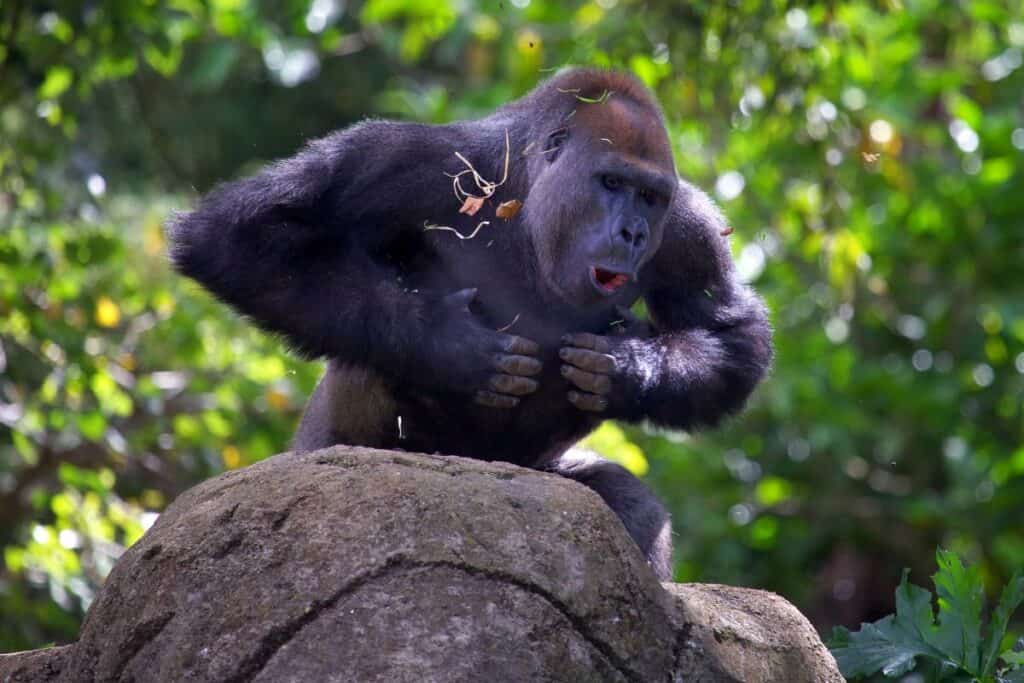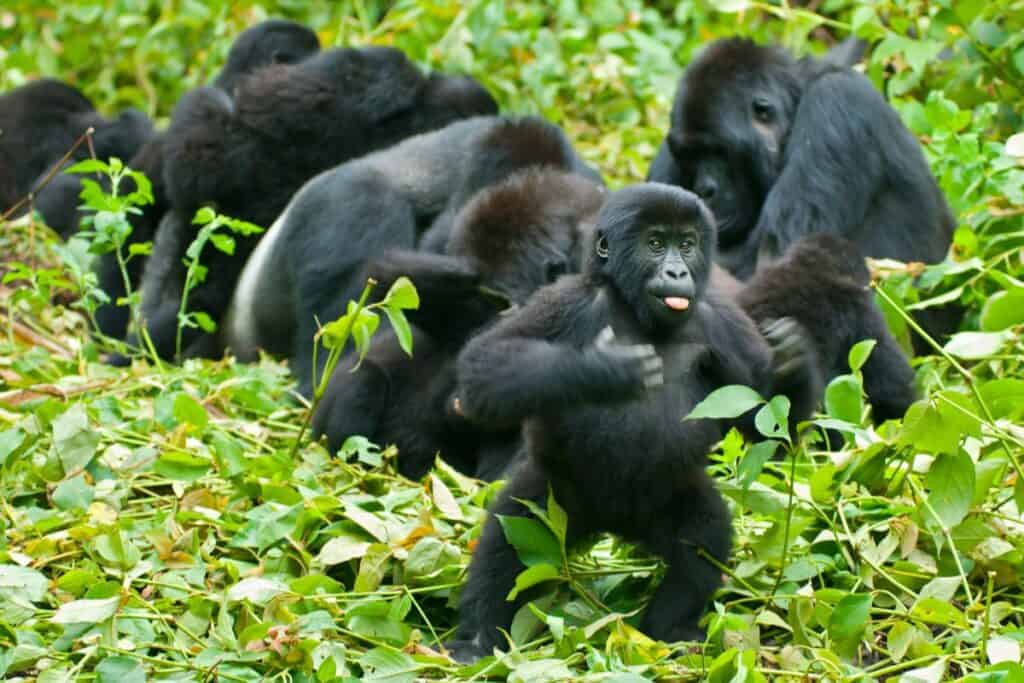King Kong is one of those films that exposed audiences globally to authentic gorilla behavior: chest-beating. Gorilla chest-beating is one of the most recognizable sounds in the animal kingdom, but why do they do it?
Gorilla chest beats are used to intimidate rival males and entice females. Adult male gorillas beat their chests, providing a reliable indicator of their body size; the larger the gorilla, the lower the sound frequency. And it can be heard from over a mile away.
The male gorilla also has a multifaceted purpose for beating his chest, similar to methods of “puffing their chests,” as seen in males of many other types of animals.

Why do gorillas beat their chests?
While scientists make many assumptions, there hasn’t yet been a study providing concrete evidence to support these claims on why gorillas’ chest-beat. However, thanks to studies conducted by international researchers, they have found that chest beats accurately predict the body size of the beater.
Body size reflects a gorilla’s capacity for competition and breeding success. This information is likely vital for competing males and females influencing mate choice.
Typically, gorillas beat their chests repeatedly with cupped hands while standing on two feet. Chest-beating is a particularly unique sound because it is, unlike something such as a lion’s roar, not a vocalization but rather a form of audible and visual-gestural communication.
In Volcanoes National Park, Rwanda, under the care of the Dian Fossey Gorilla Fund, researchers measured the body size of wild adult male mountain gorillas by recording their chest beats using a technique called photogrammetry.
The findings demonstrated that larger gorillas made sounds with lower frequencies than smaller gorillas, which may be related to the larger air sacs surrounding the larynx of the larger gorillas. The study refers to chest beating as an “honest signal of competitive ability.”
The researchers contend that chest-beating is far more reliable when gorillas hope to communicate through a dense forest habitat, even though gorillas can determine size by getting a sufficient glance at their peers. This is far easier said than done when looking through a dense jungle habitat.
This act reflects a gorilla’s fighting, competitive ability, and body size, which are crucial characteristics for competition and mate selection.
Previous studies conducted by research teams demonstrated that larger males had higher levels of social dominance and reproduction success than smaller males.
Female gorillas have many reasons to watch the displays and listen to the sounds because the peak frequency of the chest beat correlates with body size, which is associated with dominance and reproductive success.
Although this has not yet been thoroughly researched, impressive chest-beating may entice females to a nearby group.
Is gorilla chest beating a sign of aggression?
To judge the competitive ability of the chest beater and determine whether to initiate or retreat in aggressive contests with a gorilla, rival males are likely to pay attention to the body size information that is transmitted by the sounds of the chest beats.
On the other hand, females are more likely to consider this information when selecting potential partners.
Although a male gorilla’s rapid chest beat might seem to indicate aggression, new research suggests that the behavior may deter conflict between the enormous animals, which can weigh up to nearly 500 pounds at their peak.
Even though gorillas are remarkably muscular and possess long canine teeth, the animals rarely fight.
Research theorizes this partly because chest beating enables males to assess one another without engaging in physical contact.
The sound of a silverback’s chest beat may deter smaller males from approaching.
Similar to how a silverback might think a nearby smaller male is not worth bothering with after hearing his chest beats.
How is the gorilla chest beating performed?
Even though chest beating is frequently depicted in movies and other forms of popular culture, we still get many things wrong concerning it.
To begin with, gorillas in the wild do not beat their chests with balled-up fists.
Instead, they cup their hands and, contrary to what you may initially expect, it enhances the sound.
They also stand up from their sitting position, possibly as an additional measure to make sure the mighty thumps can be heard from a mile or more away.
The importance of gorilla chest beating and social interactions
Gorillas are social creatures that form close-knit family units under the leadership of silverback males, whose dominance is frequently contested by other males.
The silverbacks warn would-be rivals to stop before they start a commotion by using sounds that can travel great distances through dense rainforests to advertise their size, fighting prowess, and mating status.
Scientists have now observed silverback gorillas closely. Although studies have not explicitly examined chest-beating as a courting display, they know that males beat their chests most frequently when female gorillas enter estrus.
This is the period during which the female is sexually receptive and when they are most prepared to mate.
Male-to-male competition is fierce in gorilla social groups because they are predominately made up of one dominant male and numerous female gorillas.
Females, however, are not bound to any one social group and can move around, giving them the freedom to select their partners.
Gorillas do not bang on their chests all day. Male gorillas typically only beat their chests an average of once or twice every 10 hours.
What else is conveyed by the gorilla’s chest-beating?
There are also significant differences between male gorillas in the quantity and length of chest beats. Researchers did not appear to find a correlation between a male’s size or dominance and the frequency or duration of his chest-beating display.
However, a series of chest beats may be able to convey the male gorilla’s identity or act as a signature to other gorillas.
Male gorillas at lower social levels will also beat their chests to practice and get social feedback.
And baby gorillas as young as one-year-old have also demonstrated chest-beating while they play.

Final thoughts on gorilla chest beating
Chest beating is an important means of communication for gorillas.
It conveys information such as the size and strength of a gorilla, as well as his fighting prowess and mating status.
As it can be visually difficult to see due to the density of jungles, the fact that the sound travels far is a huge advantage.
